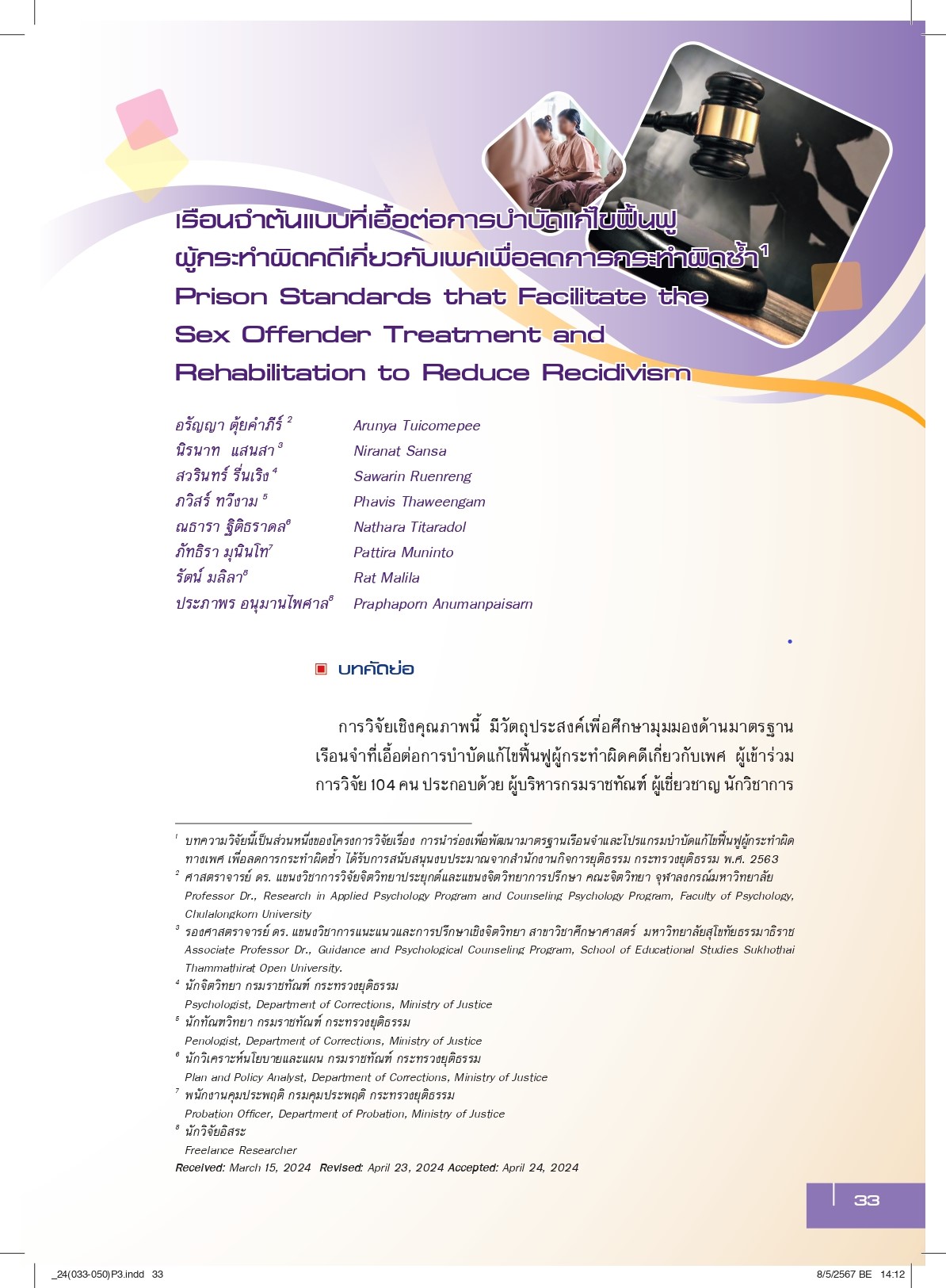Prison Standards that Facilitate the Sex Offender Treatment and Rehabilitation to Reduce Recidivism
Main Article Content
Abstract
This qualitative study is aimed to examine the perspectives of prison standards facilitating the treatment and rehabilitation of sex offenders. Research participants were one hundred and four people in total, including the executives from the Department of Corrections, experts, academics, and prison officers. In-dept interviews and focus groups were conducted for data collection. Thematic qualitative analysis using Colaizzi’s method was employed to analyze the data. The research findings revealed three main themes. The first theme was the classification standard for sex offenders. The research participants stated that prison officers were the key to effective assessment and classification of sex offenders. Major problems were a lack of qualified staff who specialized in sexual offense classification, insufficient budget, limited space for the operations and legal issues related to the sex offense. The second theme involved the treatment and rehabilitation standards for sex offenders. Participants indicated that effective rehabilitation programs were the assistance for mindset change, increase in self-esteem, promotion of novel learning, and encouragement of family participation. Major problems on the second theme included a lack of specific treatment and rehabilitation programs for sex offenders. The third theme was the standard of social reintegration for sex offenders. The participants mentioned that pre-release rehabilitation programs for sexual offenders emphasized vocational training and family relationship enhancement. Employment, cooperation among community networks, and funding for career development after release were provided. The major problems included a lack of policies or regulations for effective community reintegration. From this study, improvement of prison standards to facilitate positive changes in sex offenders can be achieved. Moreover, safe communities from sexual crimes and prevention of recidivism can be further encouraged.
Article Details

This work is licensed under a Creative Commons Attribution-NonCommercial-NoDerivatives 4.0 International License.
Published Manuscripts are the copyright of the Journal of the Justice System. However; the opinions that appeared in the content are the sole responsibility of the author.
References
Bonta, J., & Andrews, D.A. (2007). Risk-need-responsivity model for offender assessment and treatment. Public Safety Canada.
Colaizzi, P. F. (1978). Psychological research as the phenomenologist views it.In Ronald, S., King, V., & King, M. (Eds.), Existential Phenomenological Alternatives for Psychology. (p. 6). Oxford University Press.
Department of Corrections. (2563). Manual for prisoner classification.Chulalongkorn University Printing House.
Department of Corrections. (2014, Apirl 22). Recidivism Statistics of Prisoners . RECSTATS. http://www.correct.go.th/recstats/index.php
Ede, M. O., Okeke, C. I., & Onah, S. O. (2022). A randomized controlled trial of a cognitive behaviorally informed intervention for changing violent sexual attitudes among adult sexual offenders in prison. Criminal Behavior & Mental Health, 33(1), 46-61.
Office of Domestic Violence & Sex Offender Management. (2020). Standards and Guidelines for the Assessment, Evaluation, Treatment and Behavioral Monitoring of Adult Sex Offenders. Colorado Department of Public Safety Division of Criminal Justice.
Office of Justice Affairs. (2019). Summary Report of Legal Framework and Measures on Prevention of Sexual Recidivism. The Office of Justice Affairs,Ministry of Justice.
Pfäfflin, F., & Eher, R. (2011). The role of the International Association for the Treatment of Sexual Offenders (IATSO) in international public policy and practice. WILEY Online Library. https://doi.org/10.1002/9781119990420.ch34
Podhisita, C. (2021). Science and art of qualitative research (9th ed.). Amarin.
Royal Institute. (2003). Royal Institute Dictionary B.E. 2542 (1999) (6th ed.).Nanmee Books Publications.
Tuicomepee, A., Rattanadilok, K., Sansa, N., Ringkhon-at, J., Thongpibul, K.,Ruenreng, S., Titaradol, N., & Thaweengam, P. (2021). Pilot Project on Development of Prison Standards and Treatment Programs for Reducing Recidivism among Convicted Sex Offenders (A copy of research report). The Office of Justice Affairs, Ministry of Justice.


